probably neutral to beneficial; feeds on fungi in bee nests
Bakerdania Sasa, 1961
Superorder Acariformes » Order Trombidiformes » Suborder Prostigmata » Infraorder Eleutherengona » Hyporder Heterostigmata » Family Neopygmephoridae » Genus Bakerdania
Pygmephorus cultratus Berlese, 1904
Neopygmephorus Cross, 1965
Female: Posterior margin of posterior sternal plate entire (Fig. 7). Leg I subequal with leg II (Fig. 2).
Female: Tergite C not covering prodorsumprodorsum:
Dorsal surface of propodosoma.
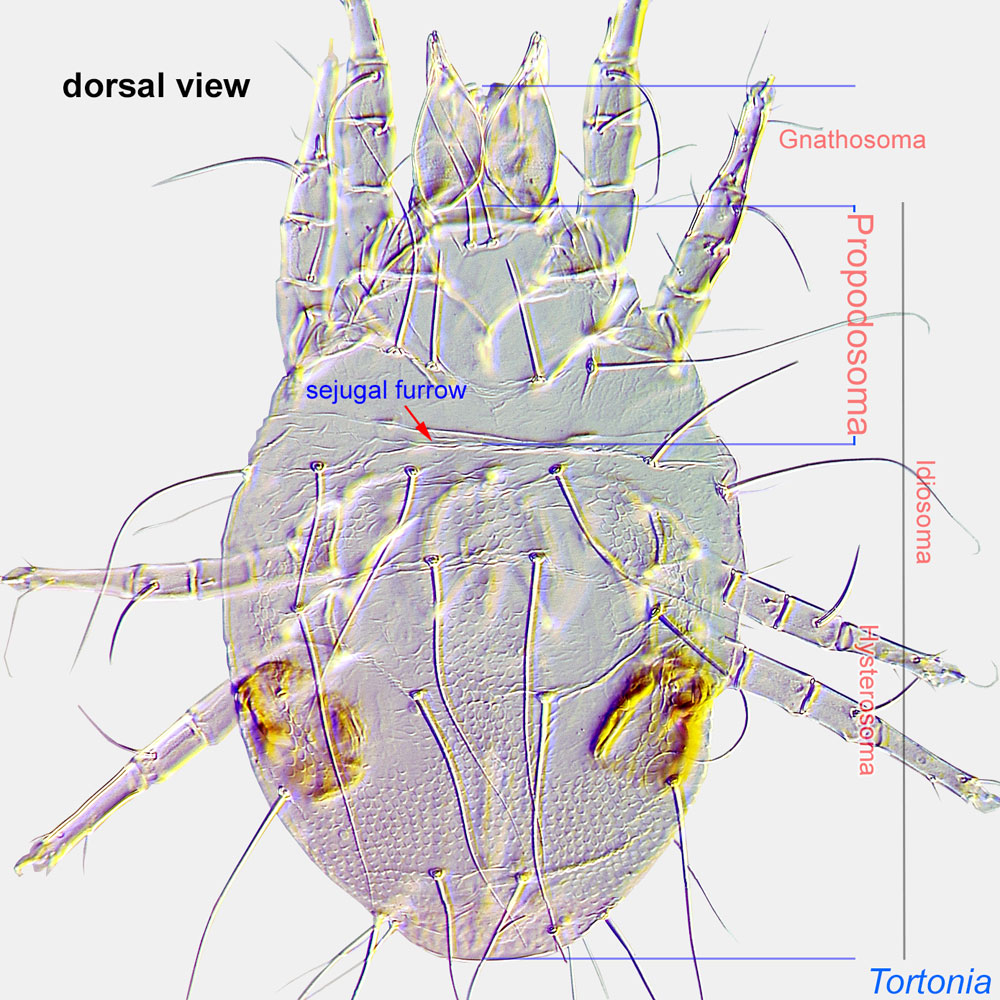 (Fig. 5). Two pairs of propodosomal dorsal setae (Fig 5). Leg I four-segmented, with tarsustarsus:
(Fig. 5). Two pairs of propodosomal dorsal setae (Fig 5). Leg I four-segmented, with tarsustarsus:
Terminal segment (also known as podomere or palpomere) of legs or palps. In Parasitoformes it can be subdivided into telotarsus and basitarsus.
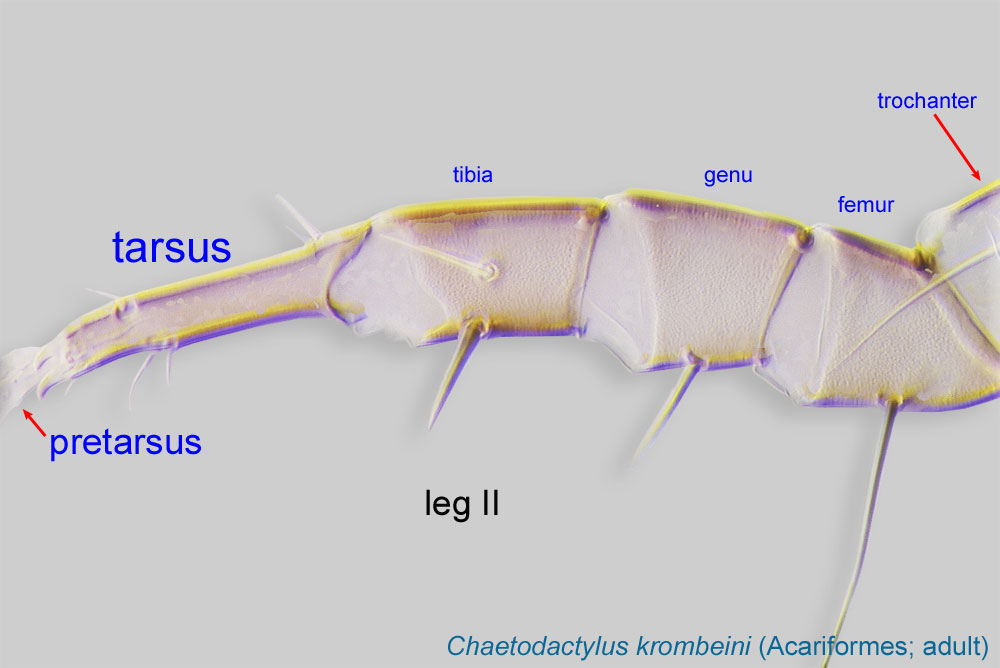 and tibiatibia:
and tibiatibia:
Leg or palp segment (also known as podomere or palpomere) between tarsus and genu.
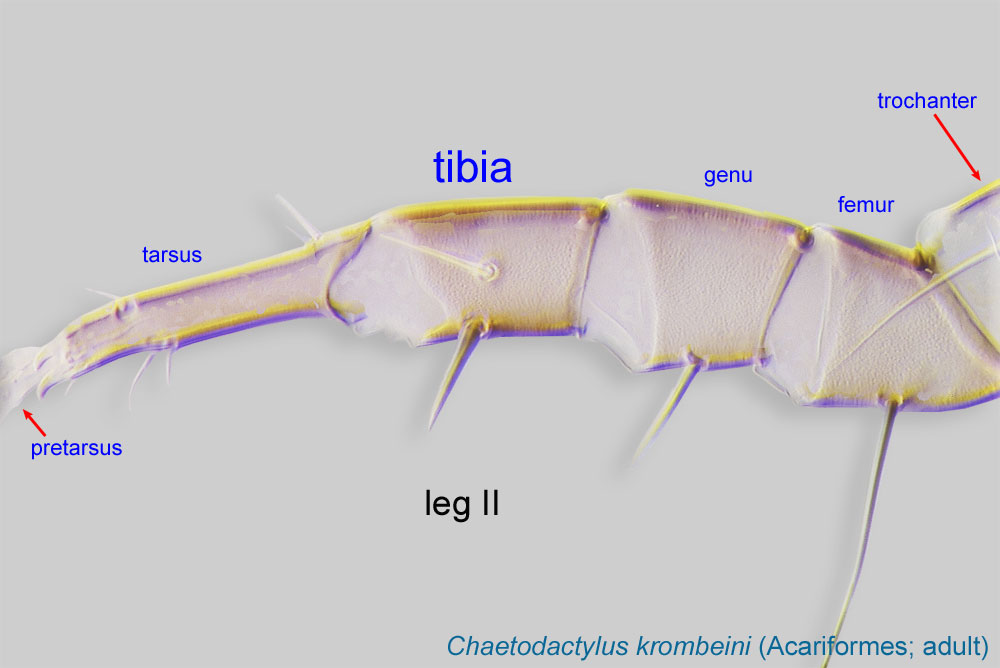 I fused forming tibiotarsus (Figs. 8). Two pairs of setae on each coxaecoxa:
I fused forming tibiotarsus (Figs. 8). Two pairs of setae on each coxaecoxa:
In Parasitiformes, most basal leg segment (or podomere) forming a joint with the body. Areas delimited by coxal apodemes are called coxal fields in Astigmata or coxisternal plates in Prostigmata.
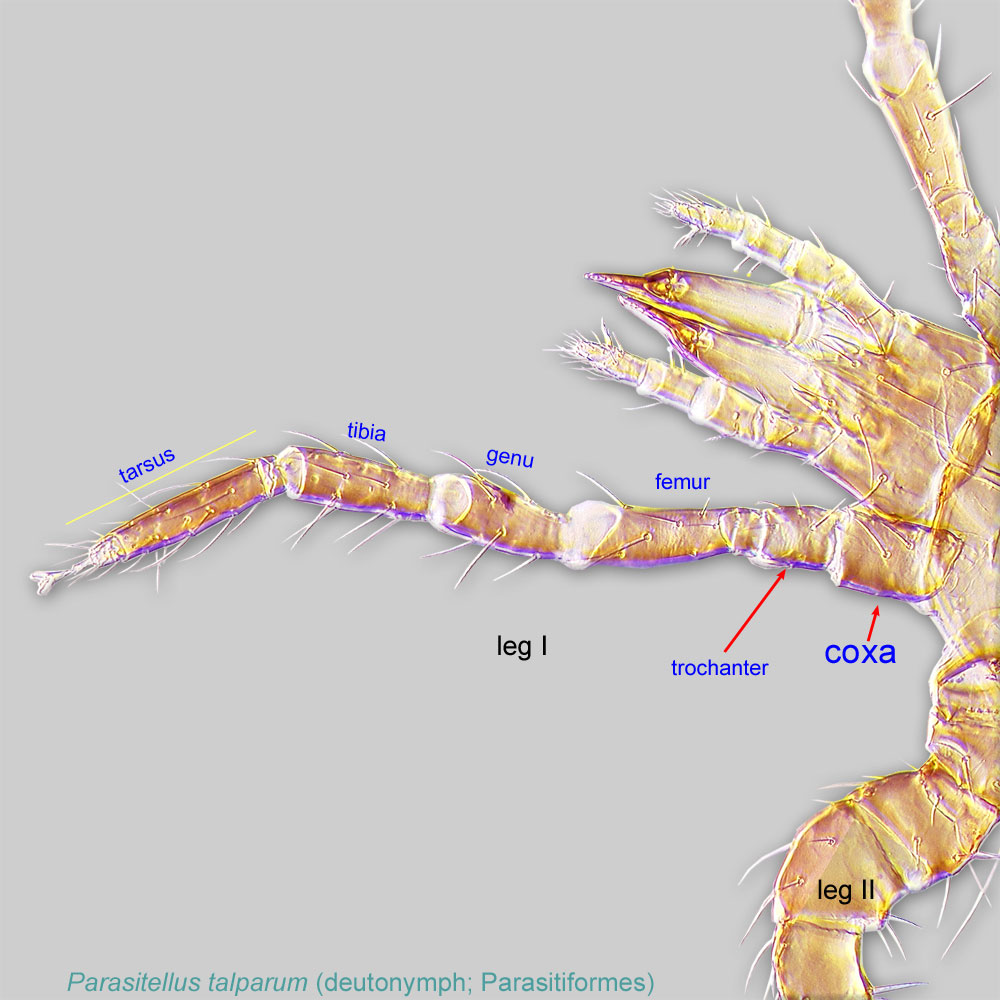 I-II (Fig. 6). Claw I medium-sized, not striated (Figs. 8). Tarsustarsus:
I-II (Fig. 6). Claw I medium-sized, not striated (Figs. 8). Tarsustarsus:
Terminal segment (also known as podomere or palpomere) of legs or palps. In Parasitoformes it can be subdivided into telotarsus and basitarsus.
 IV with claws (Fig. 9). Trochantertrochanter:
IV with claws (Fig. 9). Trochantertrochanter:
Leg or palp segment (also known as podomere or palpomere) between femur and coxa. In Acariformes this is the most basal movable leg segment (or podomere) forming a joint with the body.
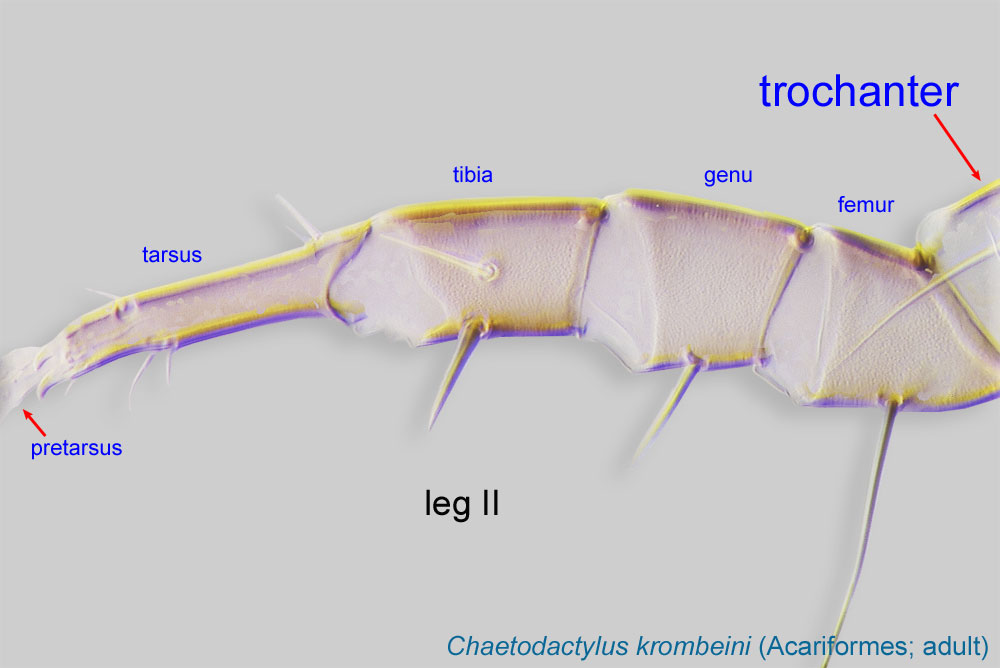 IV subquadrate (not triangular), distinctly constricted in middle part (Fig. 9). Setae d of femurfemur:
IV subquadrate (not triangular), distinctly constricted in middle part (Fig. 9). Setae d of femurfemur:
Leg or palp segment (also known as podomere or palpomere) between genu and trochanter. In ParasitIformes can be subdivided into telofemur and basifemur.
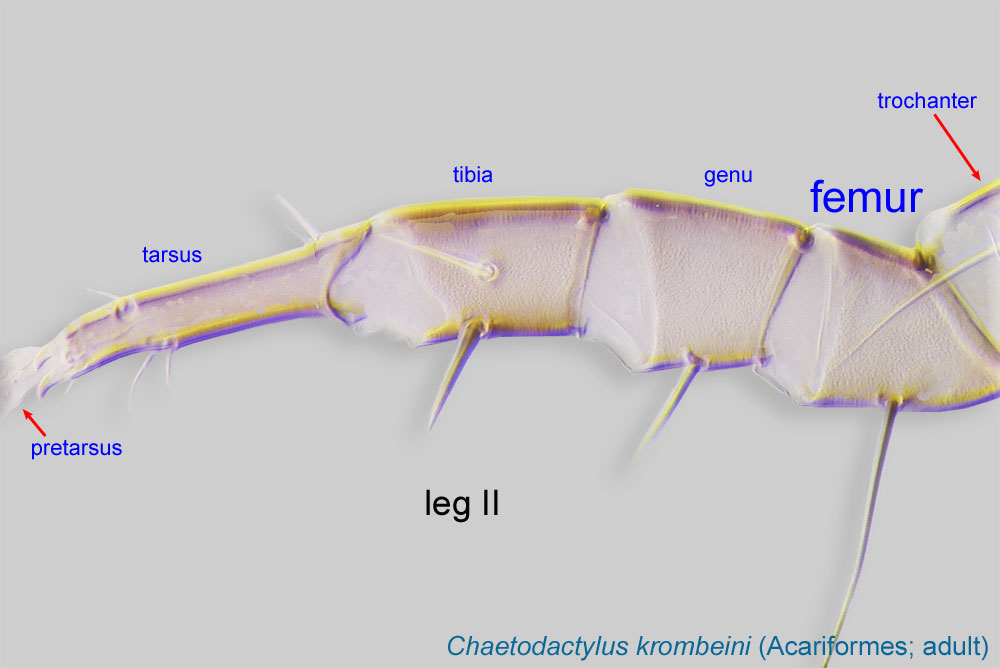 I modified, slightly widened (Fig. 8). Pinnaculumpinnaculum:
I modified, slightly widened (Fig. 8). Pinnaculumpinnaculum:
A subapical, dorsal elevation on tibiotarsus I bearing a distinct cluster of 2-3 rodlike sensory setae. Term is used for Heterostigmata only.
on tibiotarsus I absent or present, bearing 1 seta (tc'') or wide, bearing several setae (B. amplus). Basal part of gnathosomagnathosoma:
Division of body anterior to the propodosoma bearing two pairs of appendages (palps and chelicerae).
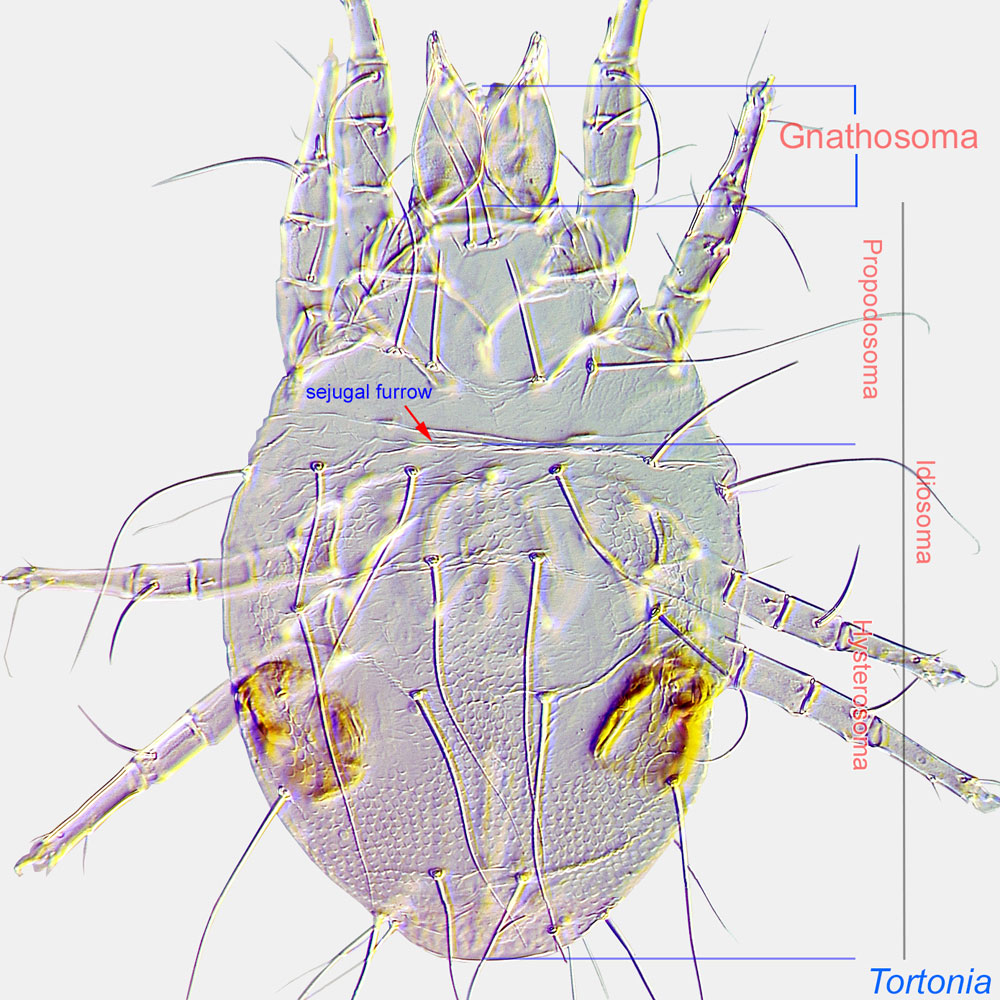 not elongated. PalpsPalp:
not elongated. PalpsPalp:
Second (after chelicera) paired appendage of the gnathosoma. Has a sensory function, but may be variously modified for other functions (e.g., raptorial, attachment to host, or filtering).
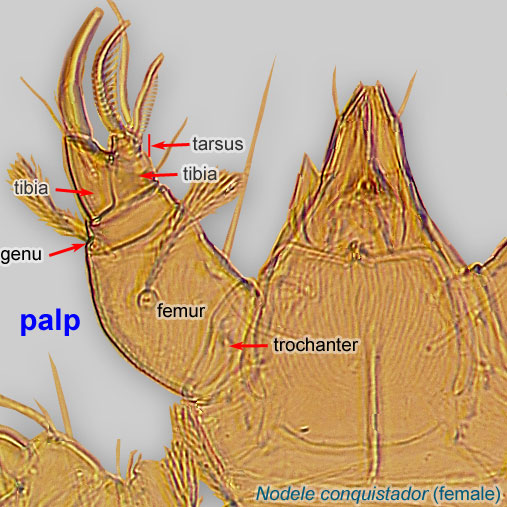 shorter than basal part of gnathosomagnathosoma:
shorter than basal part of gnathosomagnathosoma:
Division of body anterior to the propodosoma bearing two pairs of appendages (palps and chelicerae).
 (Fig. 4). Bothridial setaeBothridial seta:
(Fig. 4). Bothridial setaeBothridial seta:
A modified seta inserted in a cup-like base (bothridium); forms include filiform and capitate. Also known as bothridial sensillum and trichobothrium.
, present, clavate (Fig. 5). Median genital scleritesclerite:
A component section of an exoskeleton; a plate forming the skeleton of an arthropod.
absent (Fig. 7).
This is a species-rich genus, with no dichotomous keys available except for regional keys to species from Central Europe (Krczal, 1959Krczal, 1959:
Krczal, H. 1959. Systemik und Okologie der Pyemotiden. In Beiträge zur Systematik und Ökologie Mitteleuropäischer Acarina Bd. 1, Teil. , 385-625. H. J. Stammer, 2: 385-625 figs. 1-85.) and the Palaearctic (Sevastyanov, 1978Sevastyanov, 1978:
Sevastyanov, V. D. 1978. [Cohort Tarsonemina]. In [Opredelitel' obytayshchikh v pochve kleshchey. Trombidiformes = Mesostigmata Identification key of soil inhabiting mites. Trombidiformes], ed. M. S. Gilyarov, 14-90. Moscow: Nauka.). The only species found in association with bees, Bakerdania amplus (=Neopygmephorus amplus), can be identified by solenidionsolenidion:
Thin-walled, terminally rounded or pointed filiform or peglike structure that is not birefringent in polarized light (unlike common setae in Acariformes). Often appears striated because of its internal structure. Found on the palpal tarsus on the gnathosoma and may also occur on the tarsus and tibia, less frequently on the genu, and occasionally on the femur of legs I-IV. In Acariformes, leg solenidia often arise from unsclerotized areas.
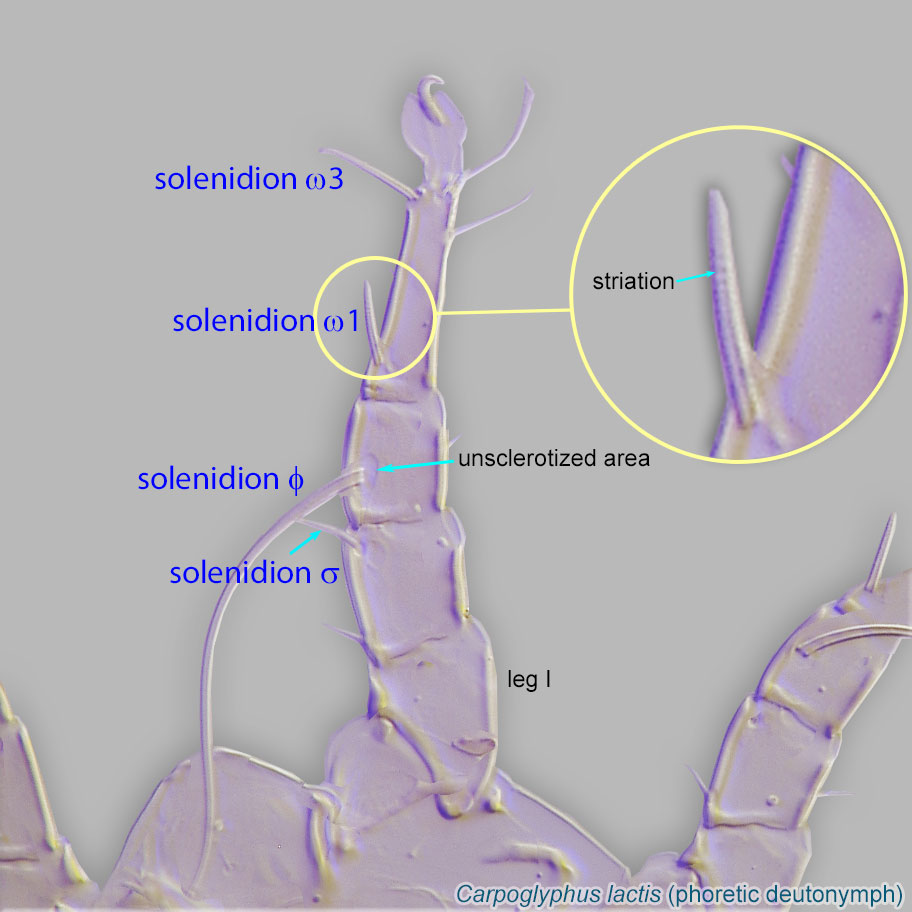 ω1 on tibiotarsus I with a characteristic bubble-shaped widening.
ω1 on tibiotarsus I with a characteristic bubble-shaped widening.
This genus is in need of revision; some species currently classified in Bakerdania should be placed in new genera (hence the boundaries of the genus Bakerdania may change in the future). Very similar to Parapygmephorus (subgenera Parapygmephorus and Sicilipes) but differs from them by trochantertrochanter:
Leg or palp segment (also known as podomere or palpomere) between femur and coxa. In Acariformes this is the most basal movable leg segment (or podomere) forming a joint with the body.
 IV distinctly constricted in middle part (not distinctly constricted in Parapygmephorus and Sicilipes). Differs from Parapygmephorus (subgenus Sicilipes) by its tibiotarsus I not enlarged (enlarged in Sicilipes). Bakerdania, Parapygmephorus and Sicilipes differ from Kerdabania by having an entire posterior margin of posterior sternal plate, whereas in Kerdabania it is tripartite, with 3 large lobes.
IV distinctly constricted in middle part (not distinctly constricted in Parapygmephorus and Sicilipes). Differs from Parapygmephorus (subgenus Sicilipes) by its tibiotarsus I not enlarged (enlarged in Sicilipes). Bakerdania, Parapygmephorus and Sicilipes differ from Kerdabania by having an entire posterior margin of posterior sternal plate, whereas in Kerdabania it is tripartite, with 3 large lobes.
Cosmopolitan. The only species found on bees (Bakerdania amplus) is from Germany.
Bakerdania amplus, the only species of this genus collected from bees, has been found in a nest of a "wild bee."
unknown, probably facultative
Unknown for the single species found in bee nests.
This genus is species-rich. Species of Bakerdania are found in a wide variety of forest and cultivated soils and other organic and plant substrates. They are probably fungivorousfungivorous:
Feeding on fungi.
, with various degrees of specificity. Females of some species were found phoreticphoretic:
Pertaining to phoresy; using another organism (i.e., a host) for dispersal to new habitats. Phoresy can be distinguished from parasitism because feeding typically does not occur during phoresy.
on Coleoptera hosts. Unusual phoreticphoretic:
Pertaining to phoresy; using another organism (i.e., a host) for dispersal to new habitats. Phoresy can be distinguished from parasitism because feeding typically does not occur during phoresy.
associations of females of Bakerdania elliptica include terrestrial isopods (Colloff and Hopkin, 1986Colloff and Hopkin, 1986:
Colloff, M. J. amp; S. P. Hopkin. 1986. The ecology, morphology and behaviour of Bakerdania elliptica (Acari: Prostigmata: Pygmephoridae), a mite associated with terrestrial isopods. Journal of Zoology Series A . 208 : 109-123.). Bakerdania elliptica may rely on phoresyphoresy:
Attaching to or boarding another organism (i.e., a host) for dispersal to new habitats. Can be distinguished from parasitism because feeding typically does not occur.
in order to gain access to patches of fungal mycelia which they would otherwise not encounter. All the attached mites are females and non-feeding while dispersing on hosts. Males are extremely rare and occur only in leaf litter.